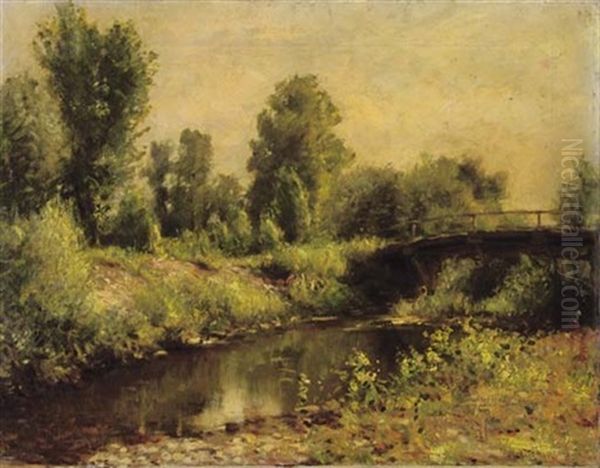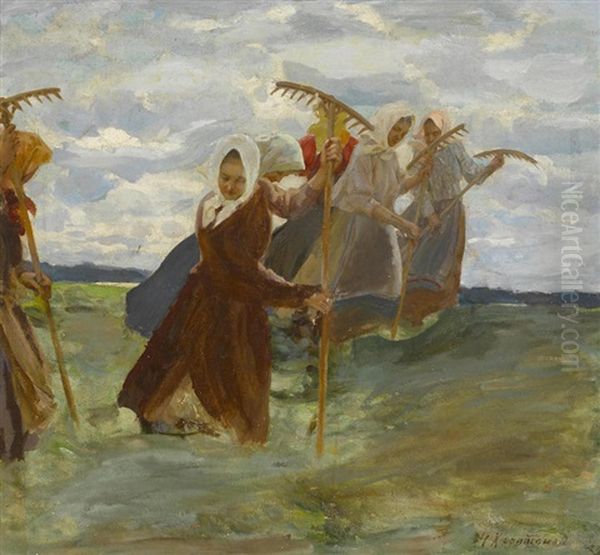Nikolai Vasilievich Kharitonov (1880-1944) was a Russian painter whose life and career spanned a period of profound transformation in Russian art and society. While not as extensively documented as some of his more revolutionary contemporaries, Kharitonov contributed to the rich tapestry of Russian visual culture, primarily through his dedication to landscape painting and themes rooted in the Russian experience. His work reflects an adherence to traditional representational art during an era that saw the explosive rise of the avant-garde and the later imposition of Socialist Realism.
Biographical Sketch and Artistic Formation
Born in 1880, Nikolai Vasilievich Kharitonov entered a world where the influence of the Peredvizhniki (the Wanderers) movement, with its emphasis on realism and socially conscious themes, was still palpable in Russian art education. His formative years as an artist would have coincided with the Silver Age of Russian Culture, a period of extraordinary artistic and intellectual ferment. While specific details about his early life, artistic training, and the institutions he may have attended are not as widely publicized as those of figures who became central to major modernist movements, it is reasonable to assume he received a solid academic grounding typical for Russian artists of his generation.
Kharitonov's career developed through the tumultuous early decades of the 20th century, encompassing the Russo-Japanese War, the 1905 Revolution, World War I, the Russian Revolution of 1917, and the subsequent establishment of the Soviet Union. These events dramatically reshaped the cultural landscape, influencing patronage, artistic themes, and the very role of the artist in society. He continued to paint throughout this period, passing away in 1944, during the height of World War II, known in Russia as the Great Patriotic War.
Artistic Style, Themes, and Influences

The available information suggests that Nikolai Vasilievich Kharitonov primarily focused on landscape painting and works with religious or traditional Russian themes. His style appears to have been rooted in the realist traditions that characterized much of Russian art in the late 19th and early 20th centuries, possibly infused with lyrical or romantic sensibilities. The description of his art sometimes touches upon a "philosophical depth" and an influence from "Byzantine and Russian traditional embroidery," which suggests an appreciation for historical Russian aesthetics and spiritual content.
However, it is important to distinguish his work from that of other artists, notably Alexander Vasilievich Kharitonov (1931-1993), a later Nonconformist artist whose work is more explicitly tied to avant-garde interpretations of religious iconography and Byzantine traditions, often employing techniques like pointillism. For Nikolai Vasilievich Kharitonov (1880-1944), the influence of such traditions would likely have manifested in a more conventional, though deeply felt, manner, aligning with a broader Russian artistic tendency to find spiritual resonance in the native landscape and cultural heritage. His approach would have been less about radical formal innovation and more about capturing the enduring essence of his subjects.
The broader artistic environment of his time was incredibly diverse. He would have witnessed the late flowering of Realism championed by artists like Ilya Repin and Vasily Surikov. Simultaneously, Russian Impressionism, brought to prominence by painters such as Konstantin Korovin and Valentin Serov, introduced new ways of capturing light and atmosphere. The Symbolist movement, with its mystical and introspective themes, found powerful expression in the works of Mikhail Vrubel and members of the Mir Iskusstva (World of Art) group like Alexandre Benois and Léon Bakst.
Notable Works
Among the documented works of Nikolai Vasilievich Kharitonov are paintings that underscore his commitment to landscape and rural scenes. Two notable examples, both dated to 1944, the year of his death, highlight his continued artistic activity even in his final year.
"Summer Harvest" (1944) is an oil painting measuring 62 x 67 cm. The title itself evokes a classic theme in Russian art, celebrating the bounty of the land and the rhythms of rural life. Such scenes often carried deeper connotations of national identity and connection to the soil, particularly resonant during times of hardship. Without viewing the specific work, one can imagine a composition rich in the colours of the Russian summer, depicting figures engaged in the timeless activity of harvesting, a subject that appealed to artists across various stylistic spectrums, from the realists to those with more idyllic visions.

Another work from the same year is "A rural landscape with a bridge" (1944), measuring 42 x 53.5 cm. Bridges in landscapes often serve as symbolic elements, representing connection, transition, or a pathway through a scene. Rural landscapes were a staple for many Russian artists, offering opportunities to explore the unique beauty of the Russian countryside, its changing seasons, and the interplay of light and shadow. These works, created towards the end of his life, suggest a consistent dedication to these themes.
The Artistic Milieu: A Time of Change and Continuity
Nikolai Vasilievich Kharitonov's career unfolded against the backdrop of one of the most dynamic periods in the history of art. When he began his artistic journey, the legacy of the 19th-century Peredvizhniki was strong. These artists, including giants like Ivan Shishkin with his majestic forest scenes and Isaac Levitan, the master of the "mood landscape," had established a powerful tradition of Russian landscape painting that was both realistic and deeply poetic. Kharitonov's work can be seen as continuing this lineage, albeit in his own individual manner.
As he matured, the early 20th century saw the explosive emergence of the Russian Avant-Garde. Figures like Kazimir Malevich with Suprematism, Wassily Kandinsky moving towards abstraction, Marc Chagall with his dreamlike visions of Vitebsk, and the Cubo-Futurist experiments of Natalia Goncharova and Mikhail Larionov were radically redefining the possibilities of art. While Kharitonov does not appear to have been a direct participant in these avant-garde movements, he would have been aware of their impact and the intense debates they generated within the artistic community.
The Mir Iskusstva (World of Art) movement, active around the turn of the century and into the early 1900s, offered another significant artistic direction. Led by figures such as Alexandre Benois, Léon Bakst, and Sergei Diaghilev (who famously brought Russian art and ballet to Paris), this group emphasized aestheticism, historical revivalism, and a synthesis of arts. Artists like Nicholas Roerich, with his mystical paintings of ancient Russia and the Himalayas, and Kuzma Petrov-Vodkin, known for his unique use of spherical perspective and vibrant colours, also carved out distinctive paths during this era.
Following the 1917 Revolution, the artistic landscape shifted again. While the early Soviet period saw a flourishing of avant-garde experimentation, by the 1930s, Socialist Realism became the officially sanctioned artistic doctrine. This style, exemplified by artists like Alexander Gerasimov and Isaak Brodsky, focused on idealized depictions of Soviet life, leaders, and achievements. Artists who did not conform to these dictates faced increasing pressure. Kharitonov, by continuing to paint landscapes and traditional themes, might have found a niche that was relatively apolitical, allowing him to pursue his artistic interests within the evolving constraints of the Soviet cultural system. His work from 1944 suggests he was still active during this later period.
Exhibitions, Recognition, and the Challenge of Documentation
Detailed records of Nikolai Vasilievich Kharitonov's participation in specific exhibitions are not as readily accessible as those for artists who were central to major, internationally recognized movements or who later became subjects of extensive art historical research. Many artists of his generation exhibited their work in group shows organized by various artistic societies or in regional exhibitions, the records of which may be less widely disseminated.
It is important to differentiate his exhibition history from that of Alexander Vasilievich Kharitonov (1931-1993), whose works, particularly those associated with Russian Nonconformist art, have been featured in significant exhibitions, including retrospectives at institutions like the Tretyakov Gallery. For Nikolai Vasilievich Kharitonov (1880-1944), his recognition would have been within the context of his time, likely among circles that appreciated traditional representational painting. The survival of his works, such as "Summer Harvest" and "A rural landscape with a bridge," and their presence in art markets or collections, indicates that his output was valued and preserved.
The art world of early 20th-century Russia was vibrant and multifaceted, with numerous societies and exhibiting opportunities beyond the most famous avant-garde showcases. Artists like Abram Arkhipov, known for his colourful depictions of peasant life, or Pyotr Konchalovsky, a member of the Jack of Diamonds group who later adapted to more realist modes, represent the diversity of artistic paths taken. Kharitonov's career would have navigated this complex environment.
Legacy and Later Assessment
Nikolai Vasilievich Kharitonov's legacy lies in his contribution to the continuum of Russian landscape and traditional painting during a period of intense artistic upheaval. While he may not have been an innovator in the mold of the avant-garde, his work represents a dedication to enduring artistic values and a connection to the Russian land and its cultural heritage. Artists who maintain a commitment to representational art during times of radical change play a crucial role in preserving artistic skills and sensibilities that might otherwise be overshadowed.
His paintings, such as those from 1944, demonstrate a lifelong engagement with his craft. In the broader narrative of Russian art, figures like Kharitonov provide a more complete picture of the artistic landscape, showing that alongside revolutionary movements, more traditional forms of expression continued to evolve and find an audience. His work can be appreciated for its intrinsic artistic qualities and as a reflection of the cultural currents of his time.
The assessment of artists like Kharitonov often benefits from a nuanced understanding of the historical context. Not every artist seeks to overturn established norms; many find profound meaning and artistic fulfillment within existing traditions, subtly reinterpreting them through their individual vision. His focus on the Russian landscape connects him to a long and revered tradition in Russian art, one that sees the natural world as a source of spiritual solace, national identity, and poetic inspiration.
Conclusion
Nikolai Vasilievich Kharitonov (1880-1944) was a Russian painter who navigated a complex and transformative era in his nation's history and art. Through his dedication to landscape painting and themes rooted in Russian tradition, he contributed to the diverse artistic output of the first half of the 20th century. While perhaps not a figure of radical innovation, his work stands as a testament to the enduring appeal of representational art and the deep connection many Russian artists felt towards their native land and cultural heritage. His paintings, like "Summer Harvest," offer a glimpse into a vision that found beauty and meaning in the timeless rhythms of nature and rural life, even amidst the profound societal and artistic shifts of his time. He remains a part of the rich, multifaceted story of Russian art, a story that encompasses not only its revolutionary breakthroughs but also its quiet continuities.